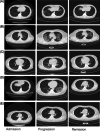The clinical characteristics of pneumonia patients coinfected with 2019 novel coronavirus and influenza virus in Wuhan, China
- PMID: 32196707
- PMCID: PMC7228290
- DOI: 10.1002/jmv.25781
The clinical characteristics of pneumonia patients coinfected with 2019 novel coronavirus and influenza virus in Wuhan, China
Abstract
The outbreak of 2019 novel coronavirus (COVID-19) infection emerged in Wuhan, China, in December 2019. Since then the novel coronavirus pneumonia disease has been spreading quickly and many countries and territories have been affected, with major outbreaks in China, South Korea, Italy, and Iran. Influenza virus has been known as a common pathogen in winter and it can cause pneumonia. It was found clinically that very few patients were diagnosed with both COVID-19 and influenza virus. A total of 5 of the 115 patients confirmed with COVID-19 were also diagnosed with influenza virus infection, with three cases being influenza A and two cases being influenza B. In this study, we describe the clinical characteristics of those patients who got infected with COVID-19 as well as influenza virus. Common symptoms at onset of illness included fever (five [100%] patients), cough (five [100%] patients), shortness of breath (five [100%] patients), nasal tampon (three [60%] patients), pharyngalgia (three [60%] patients), myalgia (two [40%] patients), fatigue (two [40%] patients), headache (two [40%] patients), and expectoration (two [40%] patients). The laboratory results showed that compared to the normal values, the patients' lymphocytes were reduced (four [80%] patients), and liver functions alanine aminotransferase and aspartate aminotransferase (two [40%] patients and two [40%] patients) and C-reactive protein (four [80%] patients) were increased when admitted to hospital. They stayed in the hospital for 14, 30, 17, 12, and 19 days (28.4 ± 7.02), respectively. The main complications for the patients were acute respiratory distress syndrome (one [20%] patients), acute liver injury (three [60%] patients), and diarrhea (two [40%] patients). All patients were given antiviral therapy (including oseltamivir), oxygen inhalation, and antibiotics. Three patients were treated with glucocorticoids including two treated with oral glucocorticoids. One of the five patients had transient hemostatic medication for hemoptysis. Fortunately, all patients did not need intensive care unit and were discharged from the hospital without death. In conclusion, those patients with both COVID-19 and influenza virus infection did not appear to show a more severe condition because based on the laboratory findings, imaging studies, and patient prognosis, they showed similar clinical characteristics as those patients with COVID-19 infection only. However, it is worth noting that the symptoms of nasal tampon and pharyngalgia may be more prone to appear for those coinfection patients.
Keywords: COVID-19; clinical characteristics; coinfection; influenza virus.
© 2020 Wiley Periodicals, Inc.
Conflict of interest statement
The authors declare that there are no conflict of interests.
Figures


References
Publication types
MeSH terms
Substances
Grants and funding
LinkOut - more resources
Full Text Sources
Medical
Research Materials

